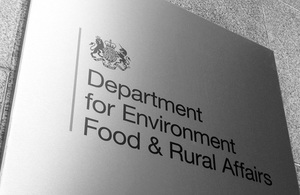Caroline Spelman's Written Ministerial Statement on Arms Length Bodies
Initial results of Arms Length Bodies review.

The Secretary of State for Environment, Food and Rural Affairs (Caroline Spelman)
The delivery of public services is at the heart of Defras role. From flood defences to animal health, from making payments to farmers to conserving biodiversity, Defra protects our natural environment, supports British food and farming industries and promotes the green economy.
But Defra has a very big network, with over 80 arms-length bodies. In my first month, I have made it my priority to examine the network critically. In line with the coalition Governmentis commitments, I am applying the three Government tests to each of our bodies: does it perform a technical function? does it need to be politically impartial? does it act independently to establish facts?
I am today announcing the first results of this work.
The Government is committed to improving the quality of life for those living and working in rural areas and intends to put the fair treatment of rural communities at the centre of Government. Ministers will lead rural policy from within my Department; I have accordingly decided to abolish the Commission for Rural Communities as an independent body.
The Commission for Rural Communities (CRC) is a Defra funded Non-Departmental Public Body that was established under the Natural Environment and Rural Communities Act on 1 October 2006.
The Government believes policy advice should be carried out by Departments, not arms length bodies. Defra will, therefore, reinforce its capacity to undertake rural work within the Department; a strengthened Rural Communities Policy Unit will work across Government to ensure that the interests of rural communities are fully reflected in policies and programmes.
In taking this action, I pay tribute to the commitment and quality of work undertaken by the Commission for Rural Communities, its staff, Commissioners and its Chairman, the Revd Dr Stuart Burgess CBE, over the past four years. My Department will continue to work closely with the CRC during the transition to the new arrangements so that we build on its achievements.
The Animal Health Agency and the Veterinary Laboratories Agency, are the two principal Defra executive agencies which work to combat animal diseases. I intend to merge these two agencies. This will allow us to bring together services, expertise and scientific capability on animal health. It will improve our resilience in delivering important services, including our animal disease emergency response capability and science requirements for animal health. In resource-constrained times, the merger will enable the agencies to create more efficient ways of working, reduce the cost and bureaucracy needed to manage the interfaces between these agencies, Defra and the devolved administrations, and their customers.
The merger of the executive agencies will go ahead shortly, with as little disruption to staff and customers as possible.
A single Chief Executive will be appointed for the new agency this summer, and will be tasked with working out how to achieve the full integration of the agencies, including structures and ways of working, by the autumn.
In the meantime, both agencies will continue to be led by their chief executives and senior teams. In implementing this change to our arms-length bodies, the Department will work closely with the Responsibility and Cost Sharing Advisory Group, as well as devolved administrations and other stakeholders.
Following the principle that Government should do only those things which only Government can do, we are examining how parts of the Defra networks assets could be marketed or be run better through the voluntary sector, while protecting key Defra outcomes. Further announcements will follow, against the principles outlined above.